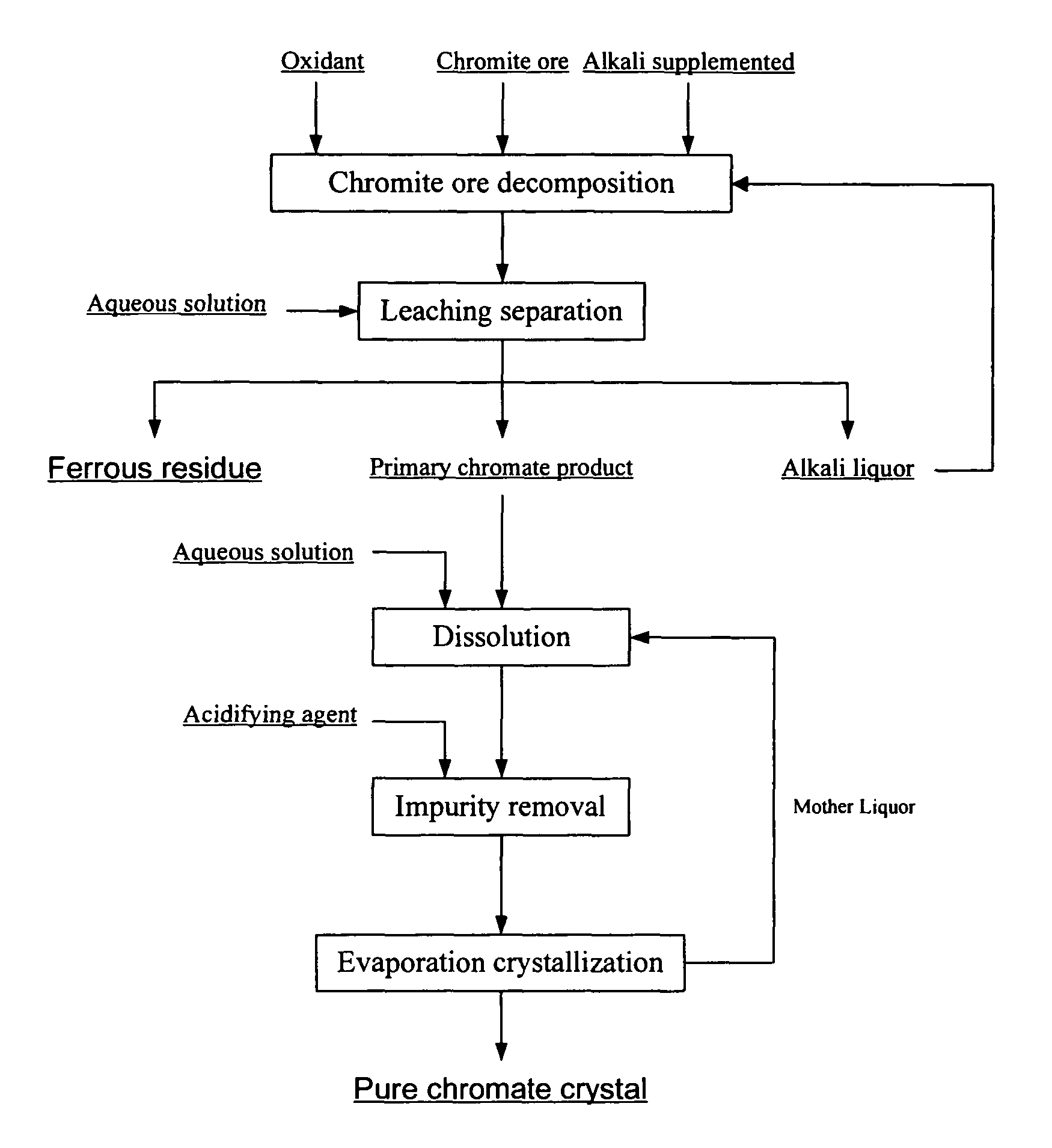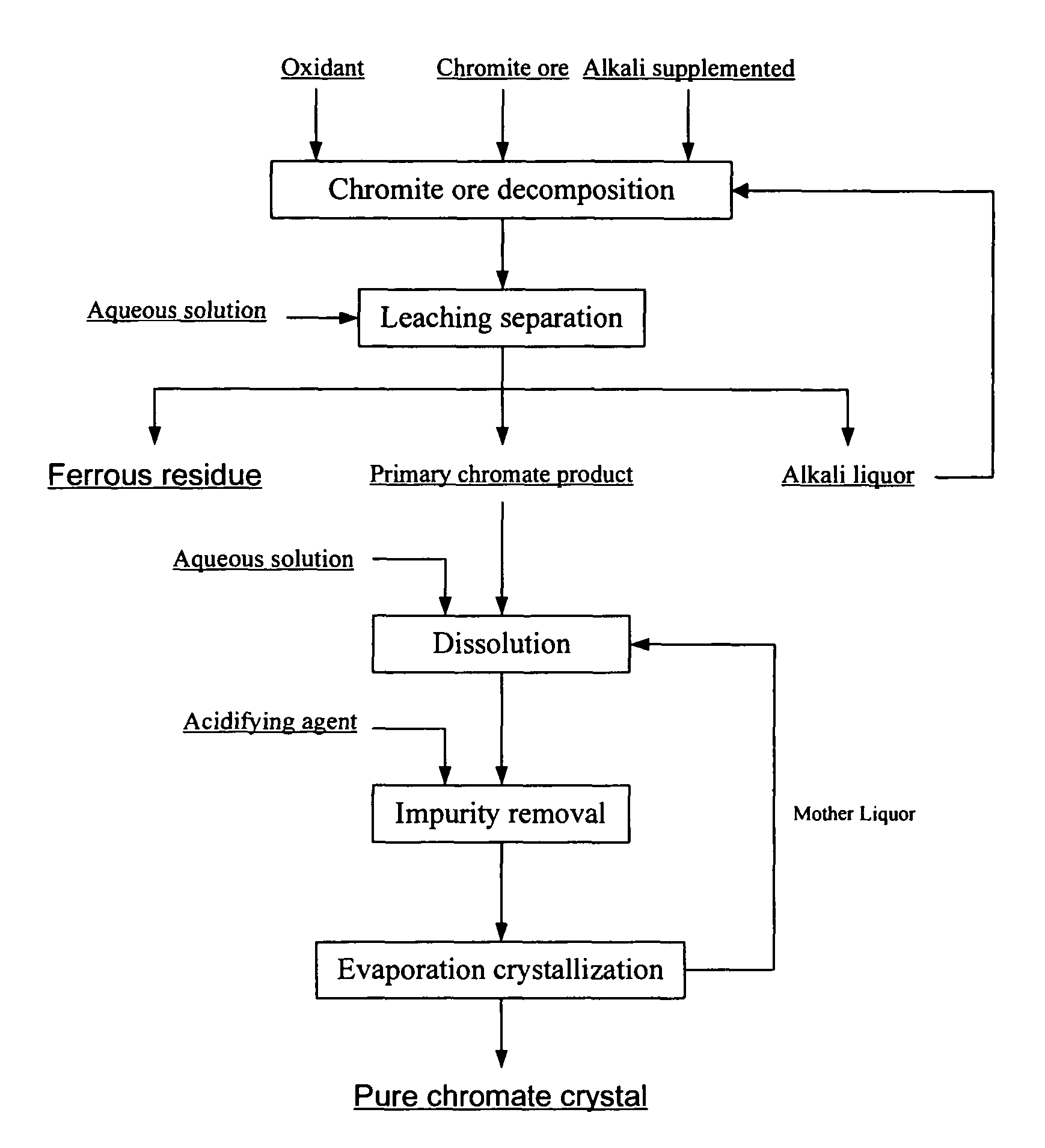Method for production of alkali metal chromates
a technology of alkali metal chromates and chromates, which is applied in the field of alkali metal chromate production, can solve the problems of large environmental threats, serious environmental pollution, and unresolved global environmental problems, and achieve the effect of reducing the chemical consumption of alkali raw materials and reducing the cost of raw materials
- Summary
- Abstract
- Description
- Claims
- Application Information
AI Technical Summary
Benefits of technology
Problems solved by technology
Method used
Image
Examples
example 1
[0036]Chromite ore with a particle size below 200 meshes, potassium hydroxide, and aqueous potassium hydroxide solution recycled to the reactor after removing part of the water are added in the reactor. The total amount of potassium hydroxide is 4 times by weight as much as that of the chromite ore. Air is then introduced to the reaction system. After completely mixed, the system is heated to 300° C. and remained for 10 hours. A mixture of alkali liquor, potassium chromate, and ferrous residue is obtained. The chromium conversion rate is higher than 99%.
[0037]Next, the mixture is leached with aqueous potassium hydroxide solution with a concentration of 30% by weight. The alkali concentration of the leached slurry is approximately 60% by weight. The primary potassium chromate product, ferrous residue, and alkali liquor are then separated after filtering the leached slurry. The chromium content of the ferrous residue is 0.055% by weight after washing and drying.
[0038]After that, the p...
example 2
[0039]Chromite ore with a particle size below 200 meshes, sodium hydroxide, and aqueous sodium hydroxide solution recycled to the reactor after removing all the water are added in the reactor. The total amount of sodium hydroxide is twice by weight as much as that of the chromite ore. Oxygen is then introduced to the reaction system. After completely mixed, the reaction system is heated to 500° C. and remained for 20 hours. A mixture of alkali liquor, sodium chromate, and ferrous residue is obtained. The chromium conversion rate is higher than 99%.
[0040]Next, the mixture is leached with aqueous sodium hydroxide solution with a concentration of 30% by weight. The alkali concentration of the leached slurry is approximately 45% by weight. The primary sodium chromate product, ferrous residue, and alkali liquor are then separated after filtering the leached slurry. The chromium content of the ferrous residue is 0.15% by weight after washing and drying.
[0041]After that, the primary sodium...
example 3
[0042]Chromite ore with a particle size below 200 meshes, potassium hydroxide, and aqueous potassium hydroxide solution recycled to the reactor after removing part of the water are added in the reactor. The total amount of potassium hydroxide is twice by weight as much as that of the chromite ore. Oxygen is then introduced to the reaction system. After completely mixed, the reaction system is heated to 350° C. and remained for 6 hours. A mixture of alkali liquor, potassium chromate, and ferrous residue is obtained. The chromium conversion rate is higher than 99%.
[0043]Next, the mixture is leached with aqueous potassium hydroxide solution with a concentration of 20% by weight. The alkali concentration of the leached slurry is approximately 40% by weight. The primary potassium chromate product, ferrous residue, and alkali liquor are then separated after filtering the leached slurry. The chromium content of the ferrous residue is 0.2% by weight after washing and drying.
[0044]After that...
PUM
| Property | Measurement | Unit |
|---|---|---|
| temperature | aaaaa | aaaaa |
| temperature | aaaaa | aaaaa |
| melting point | aaaaa | aaaaa |
Abstract
Description
Claims
Application Information
 Login to View More
Login to View More - R&D
- Intellectual Property
- Life Sciences
- Materials
- Tech Scout
- Unparalleled Data Quality
- Higher Quality Content
- 60% Fewer Hallucinations
Browse by: Latest US Patents, China's latest patents, Technical Efficacy Thesaurus, Application Domain, Technology Topic, Popular Technical Reports.
© 2025 PatSnap. All rights reserved.Legal|Privacy policy|Modern Slavery Act Transparency Statement|Sitemap|About US| Contact US: help@patsnap.com


